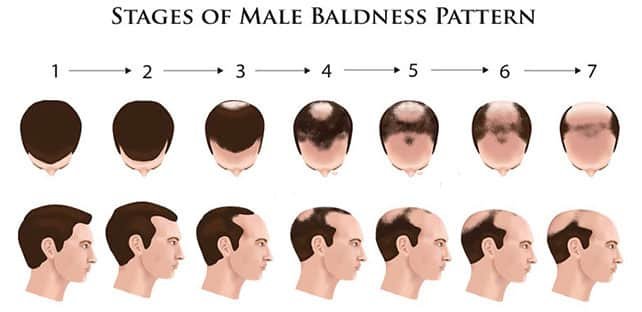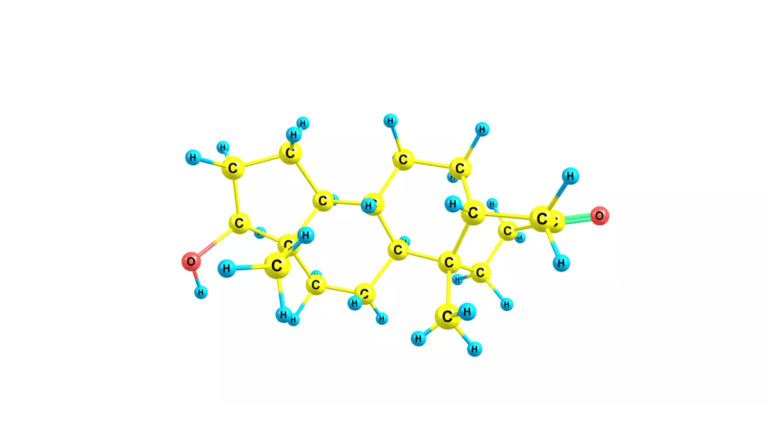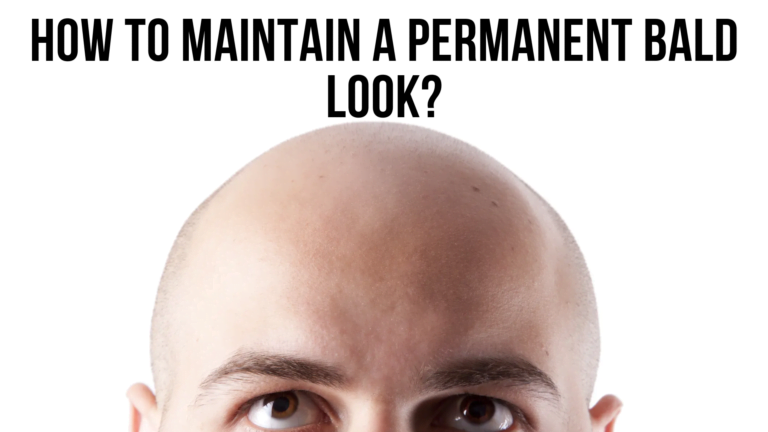Hair loss can occur for a number of reasons: stress, post-traumatic shock, deficiencies, thyroid problems, drug treatments… In these cases, the loss is often sudden and a doctor should be consulted. Androgenetic alopecia, on the other hand, is the result of a genetically determined sensitivity.
So, what is the average age men start experiencing hair loss? Read the article to find out.
AT WHAT AGE DOES BALDNESS STABILIZE?
Baldness is a process of hair loss that can affect many men and women. Here’s a very detailed article on the causes of baldness written by myself 😉
It can start at a young age, even as early as 18. There are many causes of baldness, but androgenetic alopecia is the most common in men.
It can also occur early in young men and stabilize later, around the age of 30 or 40. Hair loss may be manifest in men, but it can also affect women.
The area of the scalp affected may vary according to the general state of health and heredity of each individual.
Many hair treatments are recommended to treat hair loss and baldness, such as hair implants (hair transplants) and hair supplements.
It’s important to start baldness treatment as soon as the first signs of hair loss appear, although this can be difficult for many young men.
By the age of 25, around 20% of men start to lose their hair, while by the age of 50, almost 50% of men have significant hair loss.
The process of stabilizing baldness can take time and vary according to each individual. Results can be different for each person, depending on their general state of health and family history.
In general, baldness stabilizes between the ages of 30 and 45, but this can vary depending on many factors.
It’s advisable to wait until hair loss has stabilized before starting a hair treatment or transplant. This guarantees the best results and avoids potential problems.
Men wishing to stabilize their hair loss should consult a doctor for advice on appropriate hair treatments.
While this may be difficult for some to accept, it’s important to remember that hair loss is normal and there are many effective treatments for baldness.
It is advisable to consult a healthcare professional to discuss appropriate treatment options.
WHAT ARE THE MAIN CAUSES OF HAIR LOSS IN MEN?
Before talking about stabilizing hair loss, it’s important to understand why hair falls out, and to dispel some of the myths surrounding the issue. In most cases, the cause of hair loss is “androgenetic alopecia”, commonly known as “male pattern baldness” or “male hair loss”.
Androgenetic alopecia is not reversible; it is a genetically determined form of hair loss that affects only the top of the scalp, never the back or sides of the hair. Androgenetic alopecia affects almost all men to some degree, at some point in their lives.
Over 90% of men suffer from androgenetic alopecia. Men who suffer from androgenetic alopecia inherit hair follicles that are genetically sensitive to the effects of an androgenic hormone called “dihydrotestosterone” (DHT), a derivative of the hormone testosterone, in certain areas of the scalp.
WHAT ARE THE MAIN FACTORS IN MALE HAIR LOSS?
The two main factors contributing to androgenetic alopecia are genetics and hormones, hence the name of this pathology androgenetic is a compound word.
The first part of the word is “Andro” and the second “Genetic”. When it comes to androgenetic alopecia, it’s the genes that make the difference. They influence the speed of progression, the age at which a man is affected, the areas concerned…
Contrary to what we sometimes hear, stress in itself cannot cause hair loss; it can, however, influence the existing phenomenon by aggravating it.
On the other hand, it is true that when baldness runs in a family, there is a greater risk of hair loss: androgenetic alopecia is a genetic disease that can be inherited from one or both parents. However, it is not known exactly how baldness genes are passed on.
For example, an individual may suffer from baldness, while his father and brother have perfect, thick hair, and vice versa. It is also possible for a man to carry the baldness genes and not suffer from baldness.
It’s important to note that baldness genes alone cannot cause a man to lose his hair. It’s the presence of hormones, time and environment that allow the genes to express themselves.
DETECTION OF EARLY SIGNS OF MALE PATTERN BALDNESS
The early stages or signs of baldness are visible thinning on top, receding hairline, excessive amounts of hair on the pillow, excessive amounts of hair in the bathtub or shower bed and on brushes, combs and hands when combing hair in the morning.
However, many men don’t identify their hair loss until it’s advanced or a close friend or family member informs them.

CAN BALDNESS BE PREVENTED?
When hair loss is detected early, it is still possible to halt the process: there are several treatments that can be prescribed, which can prevent hair loss and even increase hair growth.
These treatments cannot, however, cure the problem, and only help as long as they are used. What’s more, these treatments cannot promote hair growth in bald areas where the follicles are completely damaged.
There is no specific treatment to recommend, as each case is unique and many factors need to be taken into account before giving advice.
Some of the treatments currently available are :
- hair transplant/replacement
- platelet-rich plasma,
- micropigmentation to resemble a shaved scalp,
- dermaroller,
- hairpieces,
- cosmetics,
- Minoxidil solution,
- Finasteride tablets and Dutasteride.
- Low-level laser therapy is also another safe alternative or supplementary treatment for androgenetic alopecia.
- just accept it
Certain side effects may result from the treatment used.
As there are different treatments available, side effects also vary.
For example, a topical solution may cause local irritation, while a hair transplant may result in infection. There are products dedicated to hair loss, notably thickening shampoos, which are effective to some extent.
They can simulate the appearance of hair and make it appear thicker, but they don’t really solve the problem of thinning hair, as they can’t promote new hair growth or treat follicles. Healthy hair starts inside the body.
AT WHAT AGE CAN HAIR LOSS START?
The age at which hair loss begins varies.
In most men with baldness, male pattern hair loss begins any time after puberty, when androgen levels rise in the blood.
The progression of baldness is generally very slow, taking place over several years or decades, but an earlier age of onset may foreshadow a more rapid progression.
Baldness in men progresses most rapidly in their twenties. Hair loss peaks in the thirties, and only stabilizes as androgen hormone levels in the blood gradually decline, as men get older.
HOW LONG CAN IT TAKE FOR A BALDING MAN TO GO COMPLETELY BALD?
There is no universal answer to this question. The levels of DHT present, a person’s genes and age all contribute to the speed of hair loss.
Men suffering from excessive hair loss tend to lose a large proportion of their hair before the age of 30, while others won’t see any noticeable hair loss until their late 30s or 40s.
CAN HAIR LOSS STABILIZE IN MEN WITH BALDNESS?
Often, men with baldness do not go completely bald, and hair loss stabilizes.
The ages of 30 and 40 are often cited for the stabilization of male pattern baldness, and it is often recommended to wait until a patient is at least 30 before considering hair transplantation.
What explains these stabilization ages?
In reality, this age refers to hair loss linked to androgenetic alopecia.
This baldness begins in men in their twenties, generally around the temples, and slows down as soon as the loss reaches the so-called “eternal” hairs on the sides of the scalp.
These hair fibers are spared because they are not affected by the hormone androgen. As hair loss approaches the crown line, it slows down and stabilizes.
This “equilibrium point” is particularly important with regard to possible surgical intervention: if you wish to use grafts, it is not advisable to undergo surgery until hair loss has stabilized.
This is because, if the graft is performed before the baldness has stabilized, in the long term it has an unsightly effect on the front of the head, with an unnatural-looking tuft of hair.
Gaps may also appear between the grafted hair and the crown, since hair loss will not yet have reached its stabilization threshold, and patients will have to take the risk in this case of having unattractive holes on their skulls.
In this case, there is no other option than to resort to surgery a second time.
CONCLUSION
Male pattern baldness cannot be avoided, but it can be slowed down and stabilized over time.
The best thing to do is to consult a doctor as soon as thinning hair becomes noticeable.
Prevention plays an important role in halting the process, as does lifestyle:
- follow a healthy, balanced diet,
- regular exercise,
- washing hair with a mild shampoo and avoiding damaging it with chemicals and heat are all beneficial measures for maintaining healthy hair.
Remember that hair loss doesn’t have to ruin your style, and that a clever stylist and a watchful eye can keep your hair healthy.
We hope this article has helped to clarify things for you; please feel free to consult our other articles to find out all about hair loss in men!






